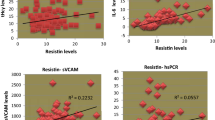Abstract.
Objectives:
Apolipoprotein (apo) E phenotype has been associated with inflammation markers. The determinants of these associations and the relationship between novel inflammation marker, resistin, and apoE phenotype are studied here.
Methods and Results:
Middle-aged subjects of the population- based cohort (n = 526) of the OPERA– study were studied. Intima-media thickness (IMT) was measured with carotid ultrasound. The results suggest that, apoE phenotype was a significant independent predictive factor for resistin (p < 0.01) and hsCRP (p < 0.01) levels. The association of ApoE phenotype with hsCRP was seen among the subjects with the normal renal function (p = 0.005). ApoE4 was associated (p < 0.01) with the lowest hsCRP in the lowest IMT quartile while it's relation with the highest resistin levels was evident in the highest IMT quartile.
Conclusions:
ApoE phenotype is an independent determinant of plasma resistin and hsCRP levels. The extent of atherosclerosis and renal function seem to modify the effects of apoE phenotype on inflammatory parameters.
Similar content being viewed by others
Author information
Authors and Affiliations
Corresponding author
Additional information
Received 6 April 2008; returned for revision 6 August 2008; received from final revision 27 October 2008; accepted by M. Katori 28 October 2008
Rights and permissions
About this article
Cite this article
Ukkola, O., Kunnari, A., Jokela, M. et al. ApoE phenotype is associated with inflammatory markers in middle-aged subjects. Inflamm. res. 58, 54–59 (2009). https://doi.org/10.1007/s00011-008-8215-2
Published:
Issue Date:
DOI: https://doi.org/10.1007/s00011-008-8215-2




